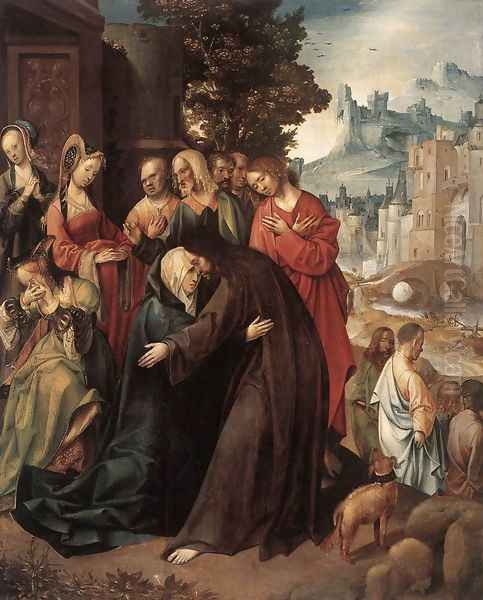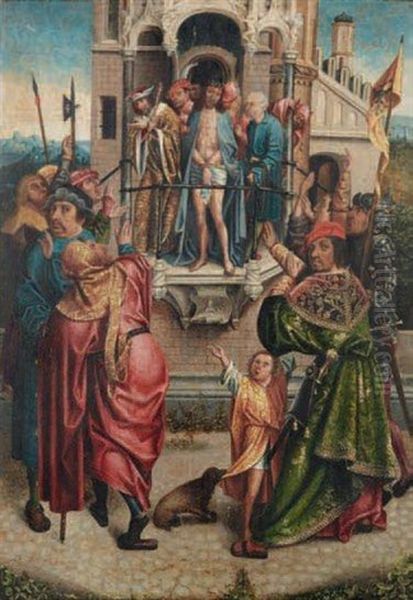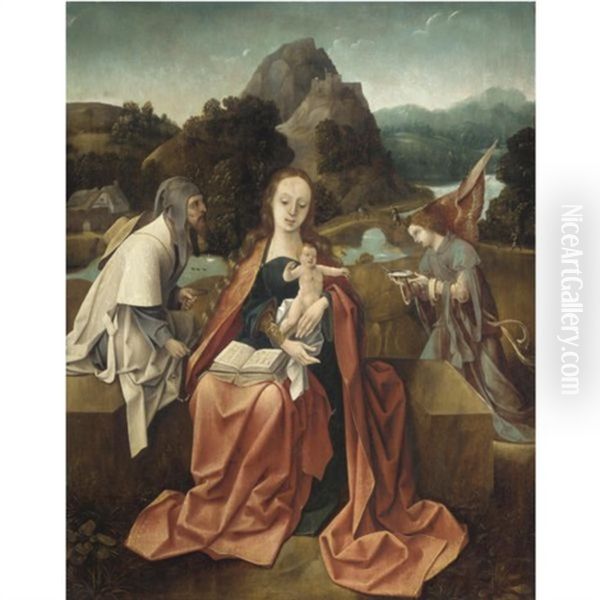Cornelis Engebrechtsz stands as a pivotal figure in the art history of the Northern Netherlands, particularly celebrated as the founder of the Leiden school of painting. Active during the late 15th and early 16th centuries, a period of significant artistic transition, Engebrechtsz bridged the gap between the late Gothic traditions and the burgeoning Renaissance sensibilities. His workshop became a crucible for artistic talent, and his influence shaped the trajectory of painting in Leiden for generations. While precise biographical details can sometimes be elusive for artists of this era, a compelling picture of his life, work, and legacy can be constructed from available records and the visual evidence of his surviving masterpieces.
Navigating the Historical Record: Birth and Demise
The exact birth and death dates of Cornelis Engebrechtsz have been subject to some scholarly debate, a common challenge when studying artists from this period due to incomplete archival records. However, a consensus has largely formed around certain timeframes. Most art historical sources suggest his birth occurred in Leiden between 1462 and 1465. This period aligns with his documented activities and the stylistic development observed in his oeuvre.
Alternative birth years, such as 1460 or 1468, have been proposed by some scholars, but these are generally considered less probable based on the broader body of evidence. The 1462-1465 window provides a plausible timeframe for his formative years and the commencement of his artistic career.
Regarding his death, the year 1527 is most widely accepted by art historians. This date is supported by various documents and the cessation of his known artistic production. While a later date, around 1533, has occasionally been mentioned, the evidence strongly favors 1527 as the year of his passing in his native Leiden. These dates frame a career that spanned a crucial era of artistic innovation and change in the Low Countries.
A Life Rooted in Leiden

Cornelis Engebrechtsz was intrinsically linked to the city of Leiden, where he was born, lived, and worked throughout his entire life. In the late 15th century, Leiden was not yet the prominent artistic center it would later become, partly due to Engebrechtsz's own contributions. His decision to establish his workshop there, rather than migrating to more established artistic hubs like Bruges, Ghent, or later Antwerp, was significant for the local artistic development.
His deep connection to Leiden is further evidenced by his participation in civic life. Records indicate his involvement with the local archers' guild (schuttersgilde), a common association for prominent citizens and artists of the time. He served as a captain of the archers' guild, specifically the St. George crossbowmen's guild, for several years, noted between 1497 and 1506. This role suggests a respected standing within the community beyond his artistic endeavors.
Around 1487, Engebrechtsz married Elysbeth Pietersdr. Their union produced several children, at least three of whom followed in their father's footsteps to become painters: Cornelis Cornelisz. Kunst (c. 1493-1544), Lucas Cornelisz. de Kock (c. 1495-1552), and Pieter Cornelisz. Kunst (c. 1490-1560/61). This familial continuation of the artistic profession was common, ensuring the transmission of workshop practices and stylistic tendencies.
The Genesis of the Leiden School
Cornelis Engebrechtsz is widely regarded as the first significant painter to emerge from Leiden and the effective founder of its distinct school of painting. Before him, Leiden did not possess a strong, independent artistic tradition comparable to other Netherlandish cities. His workshop became the primary training ground for the next generation of Leiden artists, establishing a local lineage.
His most famous pupil was undoubtedly Lucas van Leyden (c. 1494-1533), who would go on to achieve international fame as both a painter and a printmaker, becoming one of the leading figures of the Northern Renaissance. Other notable students included Aertgen Claesz. van Leyden (c. 1498-1564), who further developed the expressive qualities of the Leiden school. The presence of his own sons, Pieter, Cornelis, and Lucas, as pupils and collaborators within the workshop, solidified its central role in Leiden's artistic life.
The establishment of this workshop was crucial. It provided a structured environment for artistic training, the execution of commissions, and the development of a recognizable local style. Engebrechtsz's success attracted patronage and fostered an environment where artistic skill was valued and cultivated in Leiden.
Artistic Style: Tradition and Innovation

Engebrechtsz's artistic style is a fascinating blend of late Gothic Netherlandish tradition and emerging new influences, particularly the expressive intensity associated with Antwerp Mannerism. He was not an Italianate Renaissance painter in the vein of Jan Gossaert, but his work shows a dynamism and emotional depth that moved beyond the serene stillness of some earlier Flemish Primitives like Hans Memling or Dieric Bouts.
His compositions are often densely populated with figures, characterized by agitated movement, elongated forms, and expressive, sometimes contorted, poses. Draperies are frequently complex and voluminous, rendered with a sharp, almost brittle quality that adds to the dramatic tension of his scenes. This can be seen as a regional Netherlandish response to the desire for heightened emotional impact, paralleling developments in German art by figures like Matthias Grünewald.
The influence of Antwerp Mannerism, a stylistic trend flourishing in the early 16th century in Antwerp with artists such as Jan de Beer and the Master of 1518, is discernible in Engebrechtsz's work. This style was characterized by its artificiality, exotic costumes, elaborate architectural settings, and a penchant for dramatic, often turbulent, narratives. Engebrechtsz adapted these elements into his own distinct visual language, retaining a strong Netherlandish core. He did not directly emulate the classical harmony sought by Italian Renaissance artists, but rather pushed the expressive potential of the existing Netherlandish visual vocabulary.
His palette is typically rich and vibrant, with a fondness for deep reds, blues, and greens, often juxtaposed to create striking contrasts. The meticulous attention to detail, a hallmark of Early Netherlandish painting established by masters like Jan van Eyck and Rogier van der Weyden, is also present, particularly in the rendering of textures, fabrics, and incidental elements within his compositions.
Technical Prowess and Workshop Practices
Cornelis Engebrechtsz was a highly skilled technician, adept in the oil painting techniques that had been perfected in the Netherlands during the 15th century. His workshop practices, while rooted in tradition, also show evidence of personal innovation and a sophisticated understanding of materials.
Technical examinations of his paintings, often using methods like infrared reflectography, reveal detailed underdrawings. These preparatory sketches, typically executed with a brush or black chalk on the prepared panel, laid out the composition and guided the subsequent painting process. The presence of these underdrawings indicates careful planning, though he sometimes made adjustments (pentimenti) during the painting stages.

Engebrechtsz was a master of the layered painting technique. He would build up his images with multiple translucent glazes of oil paint over opaque underlayers. This allowed him to achieve remarkable luminosity, depth of color, and subtle tonal gradations. His handling of light and shadow was complex, contributing to the three-dimensional modeling of figures and the overall atmospheric quality of his scenes. He often used thicker paint application in darker, shadowed areas and thinner, more translucent layers for highlights, enhancing the sense of volume and drama.
A particular hallmark of his technique is the meticulous and almost sculptural rendering of rich textiles, especially gold-brocaded velvets. He developed a distinctive method for depicting these luxurious fabrics, using built-up impasto for highlights, often in yellows and orange-pinks, combined with darker glazes (like brown) to suggest the sheen and texture of the metallic threads and plush velvet pile. This careful attention to the material properties of objects within his paintings added to their realism and visual appeal.
Some sources also mention an unconventional technique of applying transparent colored glazes, almost like a varnish, over certain areas of the underpainting to achieve specific coloristic effects. For instance, a green glaze might be used to intensify the vibrancy of an underlying green or to modify another color, a practice that, while not unique, was employed by Engebrechtsz with notable skill to enhance the richness of his palette.
Major Works: Religious Narratives of Intensity
Engebrechtsz's surviving oeuvre consists primarily of religious subjects, with altarpieces and devotional panels forming the bulk of his output. These works were often commissioned by religious institutions, such as convents and churches, as well as private patrons for personal devotion.
The Triptych with the Lamentation of Christ (c. 1508, Stedelijk Museum De Lakenhal, Leiden) is one of his earliest securely attributed masterpieces. This altarpiece, likely commissioned for the Mariënpoel convent near Leiden by Jacob Martensz. Schouten, the convent's prior, depicts the sorrowful scene of Christ's body being mourned after the Crucifixion. The central panel is filled with expressive figures: the grieving Virgin Mary, St. John the Evangelist, Mary Magdalene, and other followers. Their faces and gestures convey profound anguish. The side wings typically depict donor portraits or related saints. Engebrechtsz's characteristic elongated figures and agitated drapery are already evident here, creating a powerful emotional impact. The detailed landscape and rich coloration further enhance the scene's poignancy.
The Triptych with the Crucifixion (c. 1515-1517, Stedelijk Museum De Lakenhal, Leiden) is another major work, also believed to have been commissioned for the Mariënpoel convent. This triptych presents a dramatic and crowded vision of Calvary. The central panel shows Christ on the cross, flanked by the two thieves. A multitude of figures – soldiers, onlookers, and Christ's followers – populates the scene, creating a sense of dynamic turmoil. The side panels often feature Old Testament prefigurations of the Crucifixion, such as Abraham's Sacrifice of Isaac and the Brazen Serpent, common iconographic pairings in Netherlandish art. The vibrant colors, expressive figures, and intricate details make this a compelling example of Engebrechtsz's mature style.
Other notable works attributed to Engebrechtsz or his workshop include:
Christ Taking Leave of His Mother (Rijksmuseum, Amsterdam): This panel showcases his ability to convey tender emotion within a religious narrative. The use of glazes to enrich the colors is particularly evident in works like this.
Madonna and Child (National Gallery, London): Such devotional images of the Virgin and Child were popular, and Engebrechtsz produced versions that combined traditional iconography with his personal stylistic traits.
St. Cecilia and Her Fiancé Valerian Being Crowned by an Angel (c. 1518-1520, Museum of Fine Arts, Budapest): This work demonstrates his skill in depicting narrative scenes with a rich interplay of figures and detailed settings.
The Feeding of the Five Thousand or scenes from the life of John the Baptist, such as John the Baptist Preaching, are themes he likely explored, fitting his penchant for crowded, narrative compositions. An Ecce Homo (c. 1527, Stedelijk Museum de Lakenhal) is also listed, which would depict Christ presented to the crowd, a scene ripe for dramatic portrayal.
The Last Supper: Mentioned as an early work, this would have been a significant commission, allowing for a complex figural arrangement and emotional interactions.
Many of his works were created for specific ecclesiastical contexts, and their iconography would have been carefully chosen to align with the devotional needs of the patrons and the liturgical functions of the spaces they occupied. The intensity and emotional directness of his paintings would have resonated strongly with contemporary viewers, fostering piety and contemplation.
The Teacher and His Enduring Legacy
Cornelis Engebrechtsz's most profound and lasting impact was arguably through his role as a teacher. His workshop was the dominant artistic force in Leiden during his lifetime, and he trained a significant number of painters who would carry forward and transform the city's artistic traditions.
His three sons, Pieter Cornelisz. Kunst, Cornelis Cornelisz. Kunst, and Lucas Cornelisz. de Kock, all became painters, having learned their craft in their father's studio. They continued to work in Leiden and elsewhere, disseminating aspects of his style and workshop practices. Pieter, in particular, is known to have acted as an assistant to his father on various projects.
The most celebrated of his pupils was Lucas van Leyden. Lucas was a precocious talent who quickly absorbed his master's teachings but soon developed his own highly original style, characterized by refined technique, psychological insight, and innovative compositions. Lucas van Leyden's fame as a painter and, crucially, as a printmaker, brought international recognition to Leiden as an artistic center. His prints, influenced by Albrecht Dürer but distinctly Netherlandish, circulated widely across Europe. While Lucas's style evolved beyond Engebrechtsz's, the foundational training he received was critical.
Aertgen Claesz. van Leyden was another important pupil who maintained a more overtly expressive and sometimes eccentric style, closer in spirit to Engebrechtsz's dramatic intensity. He, along with Engebrechtsz's sons, continued the Leiden tradition into the mid-16th century.
The influence of Engebrechtsz's workshop extended beyond these named individuals. He established a standard of quality and a stylistic direction that defined Leiden painting for the first half of the 16th century. Even as artistic tastes evolved with the increasing influence of Italian Renaissance art, the expressive power and technical skill championed by Engebrechtsz remained a touchstone. He laid the groundwork for Leiden's later artistic flourishing in the 17th century, which would see the emergence of masters like Jan van Goyen, Jan Steen, and, most famously, Rembrandt van Rijn, who also hailed from Leiden. While stylistically distant, the vibrant artistic culture that Engebrechtsz initiated contributed to the environment that nurtured these later giants.
His contemporaries in other Netherlandish cities included Jacob Cornelisz. van Oostsanen in Amsterdam, who shared some stylistic affinities, and the great Antwerp masters like Quentin Matsys and Joos van Cleve. Further afield, Albrecht Dürer in Germany and early Italian High Renaissance masters were transforming European art. Engebrechtsz operated within this dynamic Netherlandish context, contributing a distinct regional voice.
Later Years and Conclusion
Cornelis Engebrechtsz remained active as a painter in Leiden until his death, which, as established, most likely occurred in 1527. His later works continued to exhibit the characteristics of his mature style, though the direct involvement of his workshop and sons might have become more pronounced in larger commissions.
In summary, Cornelis Engebrechtsz was a painter of considerable skill and historical importance. He was the first major artist to establish a thriving workshop in Leiden, effectively founding the Leiden school of painting. His style, a distinctive fusion of late Gothic Netherlandish traditions with the expressive dynamism of Antwerp Mannerism, resulted in religious works of great emotional intensity and visual richness. Through his meticulous technique, his dramatic compositions, and, most significantly, his influential role as a teacher to a new generation of artists including the renowned Lucas van Leyden, Engebrechtsz left an indelible mark on the art of the Northern Netherlands. His legacy is preserved not only in his surviving paintings but also in the vibrant artistic tradition he helped to cultivate in his native city of Leiden. He stands as a testament to the rich and diverse artistic landscape of the Low Countries during a pivotal era of European art history.